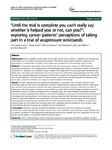“Until the trial is complete you can’t really say whether it helped you or not, can you?”: exploring cancer patients’ perceptions of taking part in a trial of acupressure wristbands
| dc.contributor.author | Hughes, JG | |
| dc.contributor.author | Russell, W | |
| dc.contributor.author | Breckons, M | |
| dc.contributor.author | Richardson, J | |
| dc.contributor.author | Lloyd-Williams, M | |
| dc.contributor.author | Molassiotis, A | |
| dc.date.accessioned | 2018-08-13T15:09:40Z | |
| dc.date.available | 2018-08-13T15:09:40Z | |
| dc.date.issued | 2013-12 | |
| dc.identifier.issn | 1472-6882 | |
| dc.identifier.issn | 1472-6882 | |
| dc.identifier.other | 260 | |
| dc.identifier.uri | http://hdl.handle.net/10026.1/12116 | |
| dc.description.abstract |
BACKGROUND: Nested qualitative studies within clinical trials provide data on patients' experiences of receiving trial interventions and can inform and improve trial designs. The present study explored patients' experiences of participating in a randomised controlled trial of acupressure wristbands for chemotherapy related nausea. METHODS: A randomised three-group sham-controlled trial was carried out to evaluate the effectiveness of acupressure wristbands in the management of chemotherapy-related nausea. A convenience sample of 26 patients volunteered to participate in a qualitative study to explore their experiences of using acupressure wristbands, and taking part in the clinical trial. Participants were recruited from each of the three UK geographical sites from which the trial was conducted: Manchester, Liverpool and Plymouth. In-depth semi-structured interviews were conducted with the participants in their own homes or other location convenient for participating patients. Interviews were audio-taped, transcribed verbatim and analysed using Framework methodology. RESULTS: The main motivational factors influencing participants to take part in the trial were a desire to 'give something back' and limit their own experience of nausea. Participants were largely satisfied with the organisation and running of the acupressure wristband trial. Many participants experienced positive outcomes as a result of taking part in the trial. Lapses in memory, or poor health as a result of their chemotherapy treatment, led to some participants failing to complete trial paperwork on designated days. Two sham wristband participants reported wearing the bands inappropriately resulting in pressure being applied to the acupoint. Almost all of the participants interviewed had only experienced mild nausea or vomiting during the trial. Participants were pragmatic on the extent to which the wristbands were responsible for this lack of nausea and vomiting during the trial. However, many participants, including some patients receiving sham acupressure, believed the wristbands to have had a positive impact on their nausea and vomiting; there was a perception that the wristbands were, at least in part, responsible for the lack of nausea and vomiting they had experienced. CONCLUSIONS: Participants perceive acupressure wristbands as reducing the level of nausea and vomiting experienced during chemotherapy treatment. Reports that some participants wore wristbands inappropriately, and/or delayed completion of trial paperwork could represent confounding variables and have implications for the trial results, and the design of clinical trials within the field of cancer. | |
| dc.format.extent | 260- | |
| dc.format.medium | Electronic | |
| dc.language | en | |
| dc.language.iso | eng | |
| dc.publisher | Springer Science and Business Media LLC | |
| dc.subject | Cancer | |
| dc.subject | Chemotherapy | |
| dc.subject | Nausea | |
| dc.subject | Vomiting | |
| dc.subject | Acupressure | |
| dc.subject | Acupressure Wristbands | |
| dc.subject | Qualitative research | |
| dc.title | “Until the trial is complete you can’t really say whether it helped you or not, can you?”: exploring cancer patients’ perceptions of taking part in a trial of acupressure wristbands | |
| dc.type | journal-article | |
| dc.type | Article | |
| plymouth.author-url | https://www.ncbi.nlm.nih.gov/pubmed/24103725 | |
| plymouth.issue | 1 | |
| plymouth.volume | 13 | |
| plymouth.publication-status | Published | |
| plymouth.journal | BMC Complementary and Alternative Medicine | |
| dc.identifier.doi | 10.1186/1472-6882-13-260 | |
| plymouth.organisational-group | /Plymouth | |
| plymouth.organisational-group | /Plymouth/Faculty of Health | |
| plymouth.organisational-group | /Plymouth/Research Groups | |
| plymouth.organisational-group | /Plymouth/Research Groups/Institute of Health and Community | |
| plymouth.organisational-group | /Plymouth/Users by role | |
| dc.publisher.place | England | |
| dcterms.dateAccepted | 2013-09-26 | |
| dc.identifier.eissn | 1472-6882 | |
| dc.rights.embargoperiod | Not known | |
| rioxxterms.versionofrecord | 10.1186/1472-6882-13-260 | |
| rioxxterms.licenseref.uri | http://www.rioxx.net/licenses/all-rights-reserved | |
| rioxxterms.licenseref.startdate | 2013-10-08 | |
| rioxxterms.type | Journal Article/Review |


